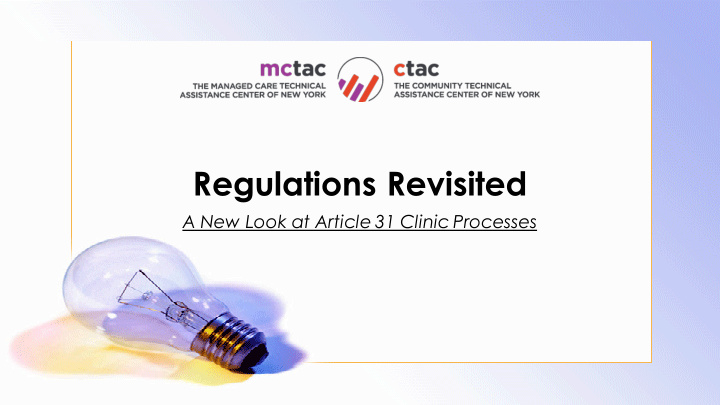



Regulations Revisited A New Look at Article 31 Clinic Processes
Introduction and Housekeeping Slides will be posted at CTACNY.org Reminders: ◦ Information and timelines are current as of the date of the presentation. ◦ The actual regulations supersedes any information provided in this reference material. ◦ This presentation is not an official document. For full details please refer to the provider and billing manuals. 2
Agenda Welcome and Training Overview Clinic Goals and Service Breakdown Key Strategies Access, Planning, Discharge and Re- admission Discussion 3
Welcome & Training Overview CTAC and MCTAC developed this training with NYS OMH Tips and recommendations provided during the presentation came from best practices currently being used in the field 4
Clinic Goals and Services 5
Clinic Goals Engage, assess, identify and diagnose Develop plan for care and treat Maximize wellness, minimize symptoms and adverse effects of illness Promote recovery and resilience Maintain individual in his or her natural environment 6
Clinic Services (Required) Injections Assessment Therapy Individual/Family/ (Adults Only) Group Medication Enhanced Services Management/ Crisis Intervention Psychotropic Complex Care Medication Treatment Management 7
Clinic Services (Optional) Testing Injections Physical Health (Children Only) Psychiatric Enhanced Services Smoking Cessation Consultation SBIRT 8
Key Strategies Team/inter-agency collaboration Engagement Timely access Data driven decision making Efficient and effective services Quality and compliance Documenting outcomes Continuous quality improvement 9
Access, Planning, Discharge and Re-admission 10
Three pre-admission Did You sessions are not mandated. Know? Assessment can continue post admission NAME OR LOGO
Pre-Admission Preadmission is just a status All services, including assessment and treatment, may be provided during pre-admission except for testing All services, including assessment, treatment, and testing may be provided after admission 12
Pre-Admission If you have determined that the individual is eligible for services, then admission is appropriate Individualizing the assessment process is key Having an individual engage in multiple appointments prior to services may erode engagement and increase no shows 13
Consider Make admission individualized/person centered Provide services prior to admission Admit sooner when appropriate Consider enhanced/other service needs (urgency of treatment, higher/other) Replace “contract for treatment” with motivational interventions
Treatment services can be Did You provided after a need has been assessed and before a full Know? comprehensive Assessment is completed NAME OR LOGO
Assessment Assessment should be an ongoing process Individuals receiving services may experience “assessment burnout” Individuals may be asked about sensitive areas before the therapeutic relationship is developed Clinicians describe drowning in documentation Lengthy assessments may decrease therapeutic time Assessment process should be individualized 16
Discussion 17
Consider Streamlined and individualized assessment process Consider removing agency specific elements/questions that go beyond requirements, or are duplicative Review assessments for potential duplication of same questions that were asked by other staff Conduct assessment as a conversation 18
Consider Access information from other sources, like PSYCKES clinical narrative, referral sources, or other assessments Consider self assessment tools for some individuals If self assessment tools are used, make sure clinicians review and utilize information Screening Tools 19
Did You Treatment planning helps an individual participate in their Know? own treatment process NAME OR LOGO
Treatment Planning Person/Child centered, youth and family driven Ongoing process of assessing needs, goals and services Identifies when goals are met A means to adjust services as necessary to assist individuals in reaching their goals Identifies when an individual is ready for discharge 21
Treatment Planning Challenges Often utilized less as a clinical tool and more to meet regulations Emphasis may be put on the paperwork rather than on the collaborative process with the individual/family There can be a disconnect between treatment planning and treatment sessions May be viewed as an event which intrudes upon therapeutic time rather than part of the treatment process 22
Consider • The treatment plan should be the individual’s plan • Using treatment planning as a tool • Document treatment planning throughout treatment • Educate the individual about the reason and need for the plan • Develop the plan collaboratively during the session 23
Did You Discharge planning should start on the first visit Know? NAME OR LOGO
Discharge Discussion begins at admission and continues throughout treatment Involves discussion to determine what changes need to occur for the individual to no longer need clinic services Lack of discharge planning can cause treatment to lose focus and take longer then needed or expected 25
Consider Short term treatment that focuses on presenting problem with clear discharge goals When there are concerns regarding client engagement, prior to discharging, try to re-engage individuals by: ◦ Determining if you are still meeting the individual’s needs or whether their needs have changed? ◦ Working with the individual to set up person centered scheduling ◦ Provide Medication-only services if appropriate ◦ Utilizing other resources/approaches for engagement ◦ Working with Health Home care managers (if available) 26
Re-admission Discussion Process Assessment Treatment Planning 27
Tips from Managed Care Organizations (MCOs) Partnership Communicate Share information Collaborate Access to care, especially post emergency room/inpatient discharge 28
Questions Comments Concerns Discussion 29
Resources 30
14 NYCRR Part 599 Regulations Establishes standards for the certification, operation and reimbursement of clinic treatment programs serving adults and children. The New York State Office of Mental Health (OMH) mental health clinic regulations, 14 NYCRR Part 599 are augmented by: ◦ The OMH Clinical Standards of Care ◦ The OMH Standards of Care Anchors, which comprise the instrument used to measure performance for re-certification. Both documents are found on the OMH Clinic webpage. https://omh.ny.gov/omhweb/clinic_restructuring/default.html 31
599 Regulations 599 Regulations: https://govt.westlaw.com/nycrr/Browse/Home/NewY ork/NewYorkCodesRulesandRegulations?guid=I9ffd00 70a18311dfa00ee4a4febaeecb&originationContext= documenttoc&transitionType=Default&contextData=( sc.Default) . 32
Additional OMH Resources Clinic Guidance: https://omh.ny.gov/omhweb/clinic_restructuring/part599/part-599.pdf Standards of Care Anchor Elements: https://www.omh.ny.gov/omhweb/clinic_standards/care_anchors.html Clinic FAQ: https://www.omh.ny.gov/omhweb/clinic_restructuring/clinic_faq.pdf Note: Program clinical leadership should review potential changes to all operations protocols with program administrative leadership. In many situations, billing staff should also be included in the discussion, even when at face value, the discussion is not about billing. 33
Contact us at ctac.info@nyu.edu
Recommend
More recommend